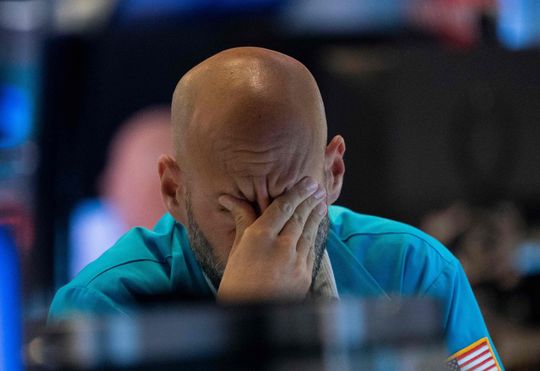‘Recession risks are more limited in 2022 but rise significantly by mid-to-late 2023,’ warn Citi analysts
Recession worries are working their way into equities, according to Citigroup.
A “mild recession in 2023” could lead to a drop of about 20% for the S&P 500 index from its late March high of around 4,600, analysts at Citigroup said in a research report Monday. Under “a more severe, macro growth scare,” the index could see a drawdown of around 30% as the Federal Reserve continues to tighten its monetary policy in an already weakening economy in order to stave off persistently high inflation, the report shows.
“Recession risks are more limited in 2022 but rise significantly by mid-to-late 2023,” the Citi analysts said. “Equity markets have begun pricing this in already, but we expect fallout to be felt mostly” in the first half of next year, they wrote.
The S&P 500 SPX was edging lower Monday afternoon to around 4,385, as companies’ earnings season for the first quarter moves into full swing this week. So far this year, the U.S. stock benchmark has dropped around 8%, FactSet data show.
S&P 500 earnings would take a 10% “hit” in 2023 under Citi’s “base recession scenario,” with the index dropping roughly 20% to around 3,650, according to the research report. More severe recessions have resulted in an average 15% decline in earnings per share, the report shows.
“Investor skittishness in the early stages of recession usually leads to multiple de-rating in the 2-3 turn range,” the analysts wrote, referring to a drop in the S&P 500’s price-to-earnings ratio. “The real concern occurs when the Fed’s policy path diverges from the macro growth backdrop,” meaning the central bank continues tightening its monetary policy while “growth inflects negatively,” the Citi analysts said. “This could take another 1-2 turns of the S&P 500’s P/E ratio,” they wrote.
The Fed has been tightening its policy by raising interest rates while also planning to shrink its balance sheet, as it aims to cool the economy to bring down high inflation in the U.S.
Traditionally defensive sectors, such as utilities, XX:SP500EW consumer staples, real estate, communication services and health care XX:SP500EW, become attractive to investors who are worried about a recession as their earnings are “less sensitive to economic activity,” according to the report.
But these sectors comprise only 35% to 40% of the S&P 500 index, the analysts said. “There is not enough market cap in defensive sectors to build a recession resistant portfolio.”
Under a “mild recession scenario, growth may also prove defensive, which would make tech relatively attractive,” they said. “However, a deeper pullback with further rate hikes likely puts pressure on higher multiple groups, meaning a quality overlay” in cyclical areas such as materials, financials XX:SP500EW, “and even industrials XX:SP500EW, should make sense,” according to the analysts.
Amid concerns over rising interest rates, growth stocks RLG have been lagging value stocks RLV this year by a wide margin, according to FactSet data.
Over the past few weeks, investors have often asked Citi analysts about how paper and packaging stocks would perform in a recession or “sharp market correction,” according to the report. “Our analysis suggests packaging is a relatively safe place for investors,” they said, “far better than paper.”
In their report, the Citi analysts assumed “equity markets started to price in more meaningfully probability of out-year recession around the late March highs as US rate curve inversions appeared, and expectations for an eventual Fed monetary policy cut worked their way into fed funds futures markets.” At that point, “the S&P 500 was trading around 4600,” they said.
A closely watched portion of the Treasury market’s yield curve had briefly inverted during trading late last month and closed in inversion in early April, meaning 2-year yields climbed above those of the 10-year Treasury note.
The last time yields on the 2-year and 10-year Treasury notes had inverted was in 2019, according to Dow Jones Market Data. An inversion of that portion of the Treasury market yield curve historically has preceded a recession, though typically a year or more prior to an economic contraction.
That part of the yield curve is no longer inverted, though, with the yield on the 10-year Treasury note BX:TMUBMUSD10Y trading at 2.86% Monday afternoon, putting it above the 2-year Treasury note’s yield BX:TMUBMUSD02Y of around 2.47%, FactSet data show, at last check.
The probability for a recession within the next year is 20%, up from 9% at the end of February, according to the Citi report.
“Investors see rising probabilities of a macro growth scare over the next 12 to 18 months,” said the Citi analysts. “Relative to previous recessions,” they expect the stock market’s response “to be earlier on both the way in and out.”
All three major U.S. stock benchmarks have sunk this year, including the S&P 500, the Dow Jones Industrial Average DJIA and the Nasdaq Composite. The tech-heavy Nasdaq COMP has seen the steepest fall so far in 2022, with a drop of around 15% based on Monday afternoon trading, amid concern that rising rates will hurt the valuations of high-flying, high-growth stocks in particular.

